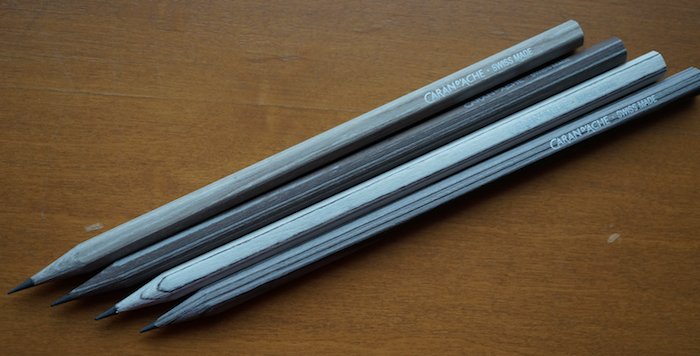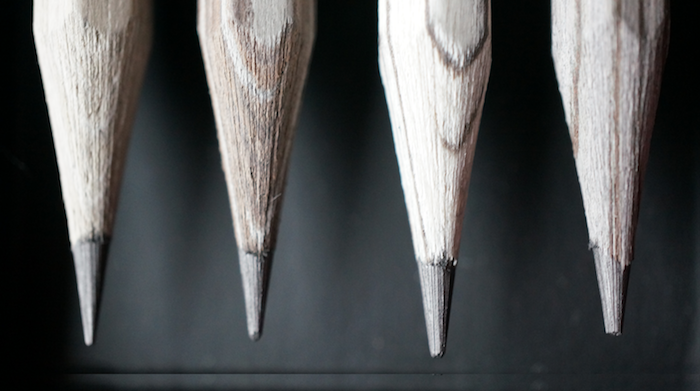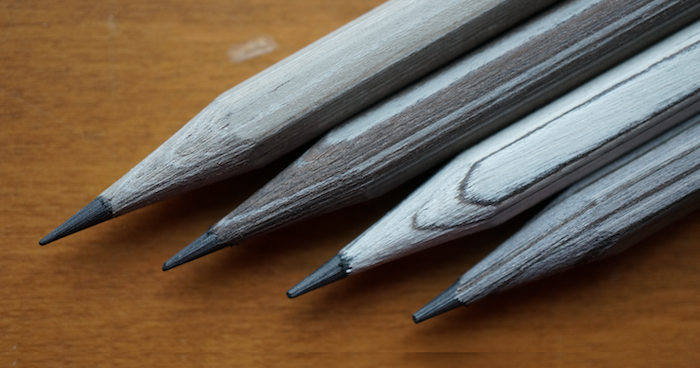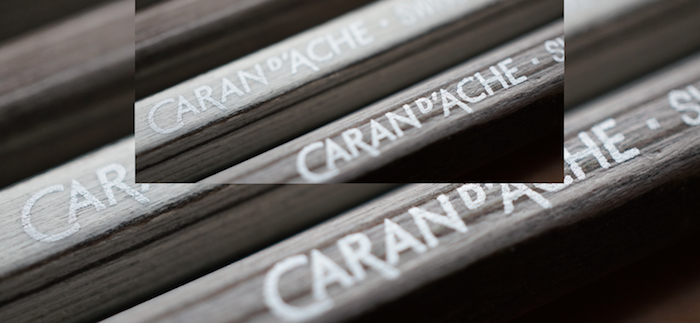Caran d’Ache has continued their “crayons de la maison” series with a sixth edition. The pencils are a visual delight, and a bit of a construction mystery.

The appeal is obvious – rich, amazing wood patterns from exotic species. They echo the 1990s Colleen Woods Pencils that are quite admired.
This set is somewhat monotone and features:
Western Hemlock
White Oak
Silver Teak
White Ash

I wish the individual pencils had a small numeral or marking to note which pencil is which.
The pencils come in a sliding cardboard box, and an external sticker indicates:
Caran d’Ache 0361 414
Bar Code: 7 630002 334990
Made in Switzerland
FSC Mix wood from responsible sources FSC C005365
We can look up the FSC number. Nothing too interesting here. Sometimes we can discover a manufacturer or subcontractor’s name by looking up this code.

A second sticker says, “Crayons Parfumés Par Mizensir”. In other words, these are scented pencils.
The scent is strong! In contrast with Viarco’s scented pencils, which require me to approach them closely before any olfactory warnings start signalling, I can detect the Mizensir scent from several feet away. Fortunately, it does seem to dissipate with time. (Mizensir is a Geneva perfumer.)
Since last featured, we know much more about this pencil series, and the vendor’s own description has been updated. Particularly informative are the comments at a 2014 post at Lexikaliker.
The pencil box notes that these pencils are made from “reconstituted wood” which they also call “essences”. ALPI is the manufacturer, and are a specialty firm in wood tasks such as creating an oak look from the woodchips of another species.

The pencils are not made from the represented exotic woods. I think even using the word “essence” is going too far – ALPI is clear that they use Poplar, Limewood, or Ayous. There is no Hemlock, Oak, Teak, or Ash in these pencils. And they weren’t made from glued together pencil slats. It is some other process, perhaps extrusion, that constructed the pencils.
Yet, they’re nice, they are innovative, and they distinguish themselves quite well from ordinary pencils. It is also quite amazing that Caran d’Ache has continued the series over three years – there is obviously a market for innovation in pencils.
See also:

Wow. So if they’re reconstituted, but yet they have a pretty definite woodgrain, does that mean they’re gluing slices of differently-colored compressed sawdust together? Or do you supposed they marbled the colors together in the hopper before they started extruding the pencils?
That’s disappointing that they’re not natural wood, or indeed made from the wood they advertise, but it’d still be interesting to know how the woodgrain looks so natural!
Andy, thanks for the comment. This is exactly why I called it a “construction mystery”.
The video below, from ALPI, suggests that thin wood chips are formed into a paper like formation, then dyed, then glued together.
Still, how do they form this around the graphite? Further, different pencils in this series may have been made with different techniques.
However they do it it’s a damned cheek charging premium prices for recycled waste. I’m glad I didn’t yield to the temptation to buy any.
I guess my rule of thumb, when approaching more expensive pens and pencils, is always to ask: do the extra bells and whistles enhance the writing experience? In this vein I could just about accept the Swiss Wood. I had reservations about this Maison series though – thought the price was all about the looks. However, I have a stationery friend who is partial to this series, and she swears the lead is better than anything out there. There may be more to this pencil than meets the eye…
BTW thank you for including me in your blog list! It’s a great honour :)
Michael, thank you for the comment. I don’t think making a product out of refuse that might otherwise end up in a landfill is at all bad – especially something transformed so nicely.
What isn’t so great is letting the public think they’re actually buying a Walnut pencil – that’s what I thought I was buying in 2013. And looking online, many people have this impression. One has to read the footnotes and look at the ALPI website to understand that these are “reconstituted wood”, and not reconstituted from Walnut.
Sola, it is a pleasure to link to your blog, which I enjoy very much.
I imagine most purchasers of these pencils are keeping them as collectibles. For this particular set, I’d say the fragrance will influence the writing experience. For me, this is a negative – I don’t want a distracting fragrance so close to me. (And I’ve already received direct feedback that my post is much too diplomatic, from someone who thinks the pencils are a “stinkbomb”!)
Thank you for the review. While the pencils look nice the misleading marketing put me off (I had the first four sets, two of each, and sold all). – I have also noticed that the sets had different hardness grades (the pencils in set 1 and 4 were considerably softer than the ones in set 2 and 3).
Two years ago I had the chance to speak to someone at the Caran d’Ache stand on the Paperworld, and although he was very reserved he made the impression that there have been two camps at the company – one wanted an open marketing which tells the buyer the truth about the material and the other, well, asserted themselves. This year I learned from an insider (not employed with Caran d’Ache) there there have been quite a few complaints because the marketing was seen as deceptive.
Sola, your approach sounds very sensible!
Gunther, it’s interesting to hear that the sets were of different grades! Learning much from your comment as usual :)
Sola, thank you :-) I also noticed that the leads had that typical “Caran d’Ache glide”, and by hindsight I’d say that the softer ones were very similar to the lead in the Grafik pencils.
Thanks for the comment, Gunther. Your recollections are most informative.
I never used them and after Gunther’s blog post where he boiled them I didn’t want to save up on a set anymore either. Reading now from you that they are parfumed is even more strange. It makes me think that CdA have this idea that with enough money you can create whatever fantasy you want. Why not… But you have to accept that it is a fantasy and not real.
PS: I’m very excited that you started posting again.
Thank you Matthias!
Yes, I had forgotten about the “hydrothermal treatment”!!
Here is the link: http://www.lexikaliker.de/2014/11/nach-art-des-hauses/
Thank you for the link!
While I can understand that most companies must always create new products they also come up with strange things now and then. I would say that scented pencils – especially those with a strong scent like these – could belong to that category, but also the pencil made from Swiss pine (sold only together with the beech pencil in the “Swiss woods” set). The Swiss pine can be found at the altitude of 1300 metres and above. It can get 1000 years old and grows very slowly – to me it should not be used for such a transient consumer item like a pencil. When I first heard of that pencil I have been amazed, mainly because I was in the Alps near Swiss pines at that time, but after thinking about it again my enthusiasm was gone.
By the way, two years ago I have contacted Walter Dei-Agnoli who is in charge of production and (as far as I know) quality control at Caran d’Ache. I have asked him about the unusual marketing of these sets and told them about the quality defects I have noticed, especially with the Grafik pencils (off-centred lead, lacquer defects) and the new Technograph (lacquer defects). Unfortunately I didn’t get a reply.